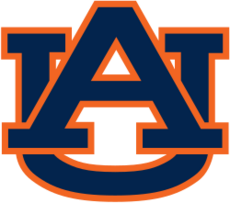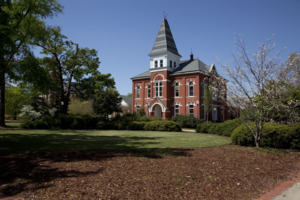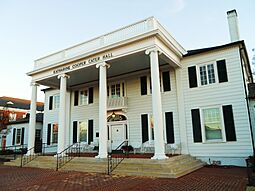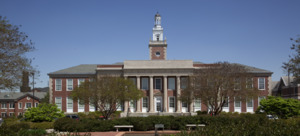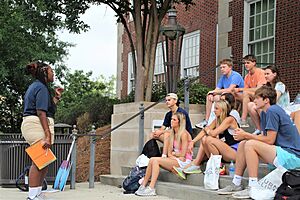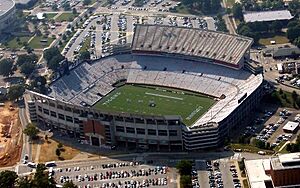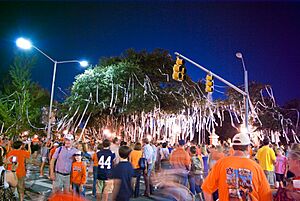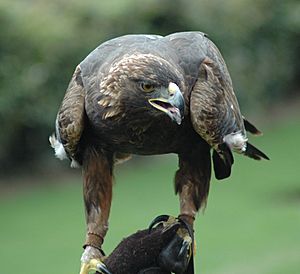Auburn University facts for kids
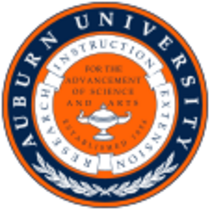 |
|
|
Former names
|
East Alabama Male College (1856–1872) Agricultural and Mechanical College of Alabama (1872–1899) Alabama Polytechnic Institute (1899–1960) |
|---|---|
| Motto | "Research, Instruction, Extension" "For the Advancement of Science and Arts" |
| Type | Public land-grant research university |
| Established | February 7, 1856 |
|
Parent institution
|
Auburn University system |
| Accreditation | SACS |
|
Academic affiliation
|
|
| Endowment | $1.19 billion (FY2024) |
| Budget | $1.85 billion (FY2025) |
| President | Christopher B. Roberts |
| Provost | Vini Nathan |
|
Academic staff
|
1,432 (2021) |
|
Administrative staff
|
3,915 (2021) |
| Students | 34,195 |
| Undergraduates | 26,874 |
| Postgraduates | 6,141 |
| Location |
,
,
United States
|
| Campus | Small City, 1,841 acres (7.45 km2) |
| Colors | Burnt orange and navy blue |
| Nickname | Tigers |
|
Sporting affiliations
|
NCAA Division I FBS – SEC |
| Mascot | Aubie the Tiger |
 |
|
Auburn University (also called AU or Auburn) is a large public university in Auburn, Alabama, United States. It is a land-grant and research university. This means it gets support from the government to focus on practical studies like agriculture and engineering, and it also does a lot of important research.
Auburn is the second-largest university in Alabama. It has over 26,800 undergraduate students and more than 6,100 graduate students. In total, over 34,000 students attend Auburn. It is known as one of the state's two main public universities. Auburn is also recognized for its very high research activity.
The university started in 1856 as the East Alabama Male College. It was a private college linked to the Methodist Church. In 1872, it became the state's first land-grant university. Its name changed to the Agricultural and Mechanical College of Alabama. In 1892, it became the first four-year school in Alabama to allow both male and female students. It was renamed Alabama Polytechnic Institute in 1899. Finally, in 1960, it became Auburn University.
In 1967, another campus was opened in Montgomery. This campus is part of the Auburn University system.
Contents
Auburn's History
Auburn University was first started on February 1, 1856. It was called the East Alabama Male College. The Methodist Church guided the college starting in 1859. Reverend William J. Sasnett was its first president. The school opened in 1859 with 80 students and 10 teachers.
Auburn's early years were closely connected to the Civil War. Classes were held in a building called "Old Main." But the college closed during the war because most students and teachers left to join the army. The campus became a training area for the Confederate Army. "Old Main" was even used as a hospital for wounded soldiers.
After the war, a cannon lathe was given to the college in 1952. This machine was used to make cannons for the Confederate Army. It is now on display next to Samford Hall on campus.
After the Civil War
The school reopened in 1866 after the Civil War ended. This was the only time it has ever closed. In 1872, the State of Alabama took control of the college. This happened because of money problems. The state made it a land-grant institution under the Morrill Act. This act provided land to be sold to fund schools focused on agriculture and mechanics. So, in 1872, the school was renamed the Agricultural and Mechanical College of Alabama.
Land-grant schools were also supposed to teach military skills. In the late 1800s, most students at the college were in a cadet program. They learned military tactics to become officers. Each county in Alabama could send two cadets to the college for free.
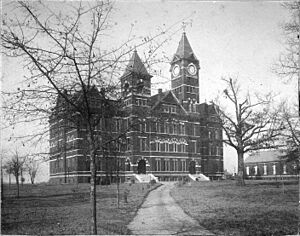
The university first focused on engineering and agriculture. This changed with William Leroy Broun, who believed in teaching both science and classic subjects. In 1892, two big things happened: women were allowed to attend the college, and football became a school sport. Football soon became the main sport on campus. In 1899, the college was renamed the Alabama Polytechnic Institute (API).
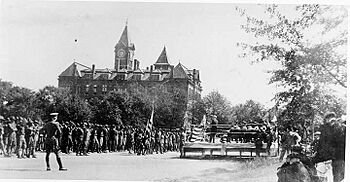
In 1918, almost all male students aged 18 or older joined the United States Army. They became part of the Student Army Training Corps on campus. The students received honorable discharges two months later when World War I ended. API faced challenges during the Great Depression. Teacher salaries were cut, and fewer students enrolled. By the end of the 1930s, Auburn had mostly recovered. But then World War II brought new challenges.
As war approached in 1940, there was a big need for engineers and scientists. The U.S. Office of Education asked engineering schools to quickly train more people. API joined this effort, offering special courses for adults. These courses helped train thousands of civilian engineers and other technical workers for the war.
During the war, API also trained U.S. military personnel. Between 1941 and 1945, 32,000 troops attended the university for training. After World War II, API grew a lot. Many returning military members used their GI Bill to get a free education. In the five years after the war, student enrollment at API more than doubled.
Becoming Auburn University
The school had grown beyond just agriculture and mechanics. So, in 1960, the Alabama Legislature gave it university status. It was renamed Auburn University. This name had been used unofficially since the 1930s. For example, Jordan-Hare Stadium opened in 1939 as "Auburn Stadium."
From the Civil Rights Era to Today
Before 1963, Auburn University only allowed white students. This changed in 1964 when Harold A. Franklin became the first African-American student. He had to go to court to be admitted to graduate school. The first degree given to an African-American student was in 1967.
Auburn University has programs to promote racial diversity. In 2018, the university started a speaker series called Critical Conversations. This series helps encourage discussions about diversity.
Campus Life and Buildings
The Auburn campus is set up like a grid. It has different groups of buildings. The northern part of campus has most of the engineering buildings and older administration offices. The middle part has buildings for liberal arts and education. The southern part has science, math, and fine arts buildings.
Over the years, many new buildings have been added. Starting in the 1950s, the campus grew a lot. To make it safer for people walking, some roads were closed to cars in 2004 and 2005. These roads were turned into concrete walkways. The university is working to make more of the campus just for pedestrians.
New construction has been ongoing since about 2000. Newer buildings often look like older ones, such as Samford Hall. The Science Center complex was finished in 2005. It has labs, classrooms, and a large lecture hall. A new medical clinic opened behind the Hill dorms. The Shelby Center for Engineering Technology opened in 2008. A new Student Center also opened in 2008.
In recent years, older buildings have been updated or replaced. In 2017, the Mell Classroom Building was added to the library. It offers new flexible learning spaces. A new 89,000-square-foot building for the nursing school also opened in 2017. It has modern classrooms and labs.
In 2019, two big projects were finished. The Brown Kopel Engineering Student Achievement Center opened. It has classrooms, study spaces, and a wind-tunnel lab. A new Graduate Business Building also opened. It has flexible classrooms and study areas.
Recent projects include a large academic complex finished in 2022. It has 2,000 seats in adaptable classrooms and labs. A new 800-seat dining hall also opened. The Tony and Libba Rane Culinary Science Center opened in August 2022. It combines teaching spaces with real restaurants and hotel areas. This allows students to get hands-on training.
A new college of education building is planned to open in 2024. It will have modern classrooms and labs. A large STEM+Ag Complex is also being built. It will replace older science and agriculture buildings. This complex will have new research labs and instructional labs for six departments. It is set to open in 2025. This complex is Auburn's biggest investment in academic buildings ever.
University Structure
Auburn University has 13 colleges and a graduate school. These are where students study different subjects.
- College of Agriculture (started 1872)
- College of Architecture, Design and Construction (started 1907)
- Raymond J. Harbert College of Business (started 1967)
- College of Education (started 1915)
- Samuel Ginn College of Engineering (started 1872)
- College of Forestry and Wildlife Sciences (started 1984)
- Honors College (started 1979)
- College of Human Sciences (started 1916)
- College of Liberal Arts (started 1986)
- College of Nursing (started 1979)
- James Harrison College of Pharmacy (started 1885)
- College of Sciences and Mathematics (started 1986)
- College of Veterinary Medicine (started 1907)
Academics and Programs
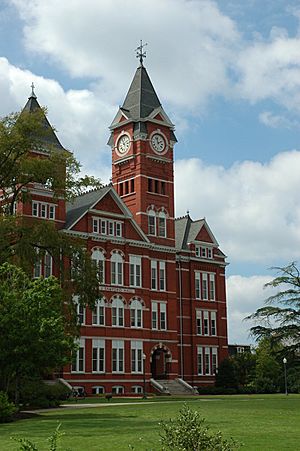
U.S. News & World Report ranks Auburn as one of the top national universities. In 2025, it was tied for 105th overall in the U.S. It was also 51st among public universities.
Auburn is a founding member of the Southeastern Conference (SEC). This conference has 15 large universities in the Southern U.S.
The College of Architecture was the first in the nation to offer a degree in interior architecture. Its Rural Studio program is also well-known. It helps students design and build homes for people in need.
The Samuel Ginn College of Engineering has a long history. It is often ranked among the largest engineering programs in the U.S. In 2001, Samuel L. Ginn, a leader in wireless communication, gave $25 million to the college. This helped Auburn create the first Bachelor of Wireless Engineering degree in the U.S. Auburn was also the first university in the Southeast to offer degrees in software engineering.
Auburn has focused on training undergraduate engineers. The Ginn College of Engineering is now growing its graduate programs. It was recently ranked 60th nationally for engineering doctoral programs.
Auburn's MBA Program in the College of Business is often ranked among the top 10% of MBA programs in the nation.
Auburn offers ROTC programs for the Air Force, Army, and Navy/Marine Corps. The Navy/Marine Corps program is the only one in Alabama. Over 100 officers who attended Auburn have become generals or admirals. This includes Carl Epting Mundy Jr., who led the U.S. Marine Corps. Auburn is one of only seven universities in the Nuclear Enlisted Commissioning Program. It has also been a top producer of Navy nuclear submarine officers.
Two four-star generals, Hugh Shelton and Richard Myers, attended Auburn for their master's degrees. Both later served as Chairman of the Joint Chiefs of Staff.
Auburn has graduated six astronauts, including Ken Mattingly of Apollo 13 fame. It also has one current and one former director of the Kennedy Space Center. Many Auburn graduates, especially engineers and scientists, work for NASA.
Auburn University owns and runs the Auburn University Regional Airport. This airport is used for flight education. Auburn's Aviation Department is fully certified by the FAA. In 2015, Auburn was the first in the nation to get FAA approval for a new Unmanned Aircraft Systems Flight School. Auburn's flight program is the second oldest university flight program in the U.S.
The Old Rotation on campus is the oldest continuous agricultural experiment in the Southeast. It dates back to 1896.
Auburn also has a Master of Real Estate Development program. This program helps train professionals for the real estate industry in Alabama.
Auburn's literary journal, the Southern Humanities Review, has been published since 1967. Auburn also hosts the editorial offices for the Encyclopedia of Alabama.
Student Life
Auburn is known for its many campus activities and events. These begin with orientation programs for new students. Camp War Eagle helps new freshmen and their families get used to college life. Successfully Orienting Students is for students transferring from other schools. First-year students can also join seminars and learning communities.
Other popular events include the First 56 and Hey Day. First 56 is a series of programs during the first 56 days of the Fall semester. It welcomes both new and returning students. Hey Day is a long-standing tradition where everyone on campus wears nametags and greets each other. This tradition started during World War II.
Dining Options
In 2021, Auburn opened a large Central Dining Hall. It is 48,000 square feet and can seat over 800 people. It has eight different meal stations. Students also have other dining options like Foy Hall and The Village dining halls. There are also popular restaurant chains like Chick-fil-A and Starbucks. Local food trucks are also available around campus.
All Auburn students can get meal plans. These plans can be used at all on-campus dining spots. Students can choose plans with meal swipes or dining dollars. Campus dining uses the Grubhub app for mobile food ordering.
Auburn's dining services work to be sustainable. They try to reduce food waste and packaging. They also use a local campus community garden for fresh food. Auburn also helps students who might not have enough food. The Campus Food Pantry is available for students facing food insecurity.
Student Housing
Auburn's first campus plan was designed in 1929. For much of Auburn's early history, students lived in boarding houses and barracks. Modern residence halls began to be built during the Great Depression. As the university changed from military training to more academic studies, more dorms replaced the old barracks.
Auburn has 30 residence halls in nine areas. They house 4,800 students.
- The Quad is the oldest housing area. It has ten buildings for undergraduate students. Most rooms are double-occupancy with a shared bathroom.
- The Hill has six buildings, mostly for undergraduates. It includes two tall dorms. All dorms are coed with separate floors for genders. Rooms are similar to The Quad.
- The Village was built in 2009. It has eight buildings for 1,500 residents. Three buildings house sorority members. Most rooms are suites with four single bedrooms, two bathrooms, and a shared living area.
- Cambridge Hall is a five-story hall for 300 undergraduate students. Rooms are double occupancy with shared bathrooms.
- South Donahue opened in 2013. It is a five-story hall next to the baseball stadium. Most suites have two bedrooms, private bathrooms, a living room, and a kitchenette. Each suite also has a TV and washer/dryer.
- 160 Ross is an apartment community. It offers four-bedroom or two-bedroom apartments with many amenities.
Health and Recreation
Auburn's campus recreation center is a large facility. It has a five-story cardio tower and an indoor running track. It also has basketball courts, an outdoor pool, and a rock climbing wall. There are areas for weight training and outdoor sports. This center was recognized as one of the best facilities in 2014.
Auburn has over 20 club sports. These are open to all students and are not part of the NCAA. Club sports include basketball, volleyball, clay shooting, and water skiing. Auburn also offers Intramural Sports like flag football.
Students have access to many wellness programs. There is a Medical Clinic on campus with exam rooms and lab equipment. The Student Counseling and Psychological Services office offers health counseling. The Medical Clinic also has a pharmacy, women's health center, massage therapy, and chiropractic care.
Student Groups
Auburn has many student clubs and organizations. These include the Student Government Association and the University Program Council. There are also groups like the Black Student Union and the International Student Organization. Many service organizations are also available, such as Auburn University Dream Makers.
The Auburn Plainsman is a student-run newspaper. It covers news about Auburn University and the community. It has won many awards for student publications. As of 2021, it is mainly an online publication.
Other student media groups include Eagle Eye TV, WEGL 91.1 FM radio, The Circle literary magazine, and the Glomerata yearbook.
The Auburn University Marching Band has over 350 members. It won a prestigious award in 2004. The band includes a majorette, dance, and flag line.
Greek Life
Auburn has a Greek system with fraternities and sororities. As of Fall 2020, about 33.6% of undergraduate students are part of Greek life.
The first African-American student joined a historically white sorority in 2001. Historically white fraternities began to include non-white students in the 1990s. Since the early 2000s, more non-white students have joined these groups each year. In 2018, an African-American student became the first person of color president of a historically white Greek organization on campus. Only Auburn's historically white fraternities have traditional Greek houses.
Student Support
Auburn students have many resources to help them. For academics, students can get help from advisors, peer tutors, and the Miller Writing Center. The Office of Accessibility helps students with learning needs.
The Auburn Office of Inclusion and Diversity works to make diversity a core value at the university. This office manages student programs, training, and a cross-cultural center. Auburn also has a task force to address fairness and inclusion on campus.
The Auburn Cares office helps students during a crisis or emergency. It connects students with resources and support.
The Veterans Resource Center helps military-affiliated students. It connects student veterans and provides resources to help them adjust to university life.
Auburn Athletics
Auburn University's sports teams are called the Tigers. They compete in the NCAA at the Division I FBS level. They are also part of the Southeastern Conference (SEC). "War Eagle" is the famous battle cry and greeting used by Auburn fans.
Auburn has won 26 national championships in various sports. This includes five in football. They have also won 70 SEC championships. Auburn's colors, burnt orange and navy blue, were chosen by George Petrie, Auburn's first football coach. He picked them based on his old school, the University of Virginia.
Football Team
Hugh Freeze became Auburn's new football head coach in November 2022. Famous past coaches include Ralph "Shug" Jordan and Pat Dye.
Auburn played its first football game in 1892 against the University of Georgia. This started one of the oldest college football rivalries in the Deep South. Auburn's first perfect season was in 1913. They went 8–0 and won their first national championship. Auburn's first bowl game was in 1937 in Cuba.
Auburn football has won twelve SEC Conference Championships. They play their main rival, Alabama, each year in a game called the Iron Bowl.
Three Auburn players have won the Heisman Trophy. These are Pat Sullivan (1971), Bo Jackson (1985), and Cam Newton (2010). John Heisman, the trophy's namesake, coached at Auburn from 1895 to 1899. Auburn is the only school where Heisman coached that has produced multiple Heisman winners. Auburn's Jordan-Hare Stadium can hold 87,451 fans. It is one of the largest on-campus stadiums in the NCAA.
In 1993, Auburn went 11–0 but could not play in the SEC Championship game due to probation. In 2004, Auburn finished the football season with a 13–0 record. They won the SEC championship, their first since 1989. The 2004 team was led by quarterback Jason Campbell and running backs Carnell Williams and Ronnie Brown. However, they were ranked behind two other undefeated teams and did not play in the BCS championship game.
In 2010, Auburn beat Oregon 22–19 in the 2011 BCS National Championship Game. This secured the school's second national championship. The Tigers finished the season with a 14–0 record. This included amazing comeback wins against Clemson, South Carolina, Georgia, and Alabama. They came back from being down 24–0 against Alabama to win 28–27. Auburn then beat South Carolina 56–17 in the 2010 SEC Championship Game. The team was led by coach Gene Chizik, offensive coordinator Gus Malzahn, and Heisman winner Cam Newton.
In Malzahn's first season as head coach (2013), Auburn had two incredible finishes against Georgia and Alabama. They won the SEC West and then the 2013 SEC Championship Game against Missouri. They lost a close game to the Florida State Seminoles in the 2014 BCS National Championship Game.
Besides the 1913, 1957, and 2010 championships, Auburn's 1914, 1958, 1983, 1993, and 2004 teams have also been recognized as national champions by various ranking groups.
Swimming and Diving
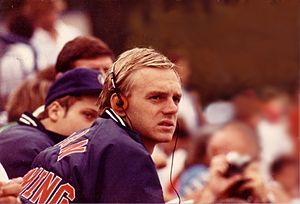
Auburn's swimming and diving program has been very successful. They won consecutive NCAA championships for both men and women in 2003 and 2004, and again in 2006 and 2007. The men's team won their fifth national title in a row in 2007. The women's team won their second straight national title that year. As of 2009, the Auburn men's team has won the SEC Championship 15 times in 16 years. They have also won eight NCAA national championships.
Auburn swimmers have represented the U.S. and other countries in the Olympic Games. Famous Auburn swimmers include Olympic gold medalist Rowdy Gaines and Brazilian César Cielo Filho. Kirsty Coventry from Zimbabwe, a very successful female Olympic swimmer, also attended Auburn. While football is more famous, Auburn's swimming and diving program is very dominant.
Men's Basketball
The Auburn men's basketball team has had good and bad seasons. Its most famous player is Charles Barkley. Other professional basketball players from Auburn include John Mengelt and Chuck Person.
Women's Basketball
The Auburn University women's basketball team has been strong in the SEC and nationally. They have won four regular season SEC championships and four SEC Tournament championships. Auburn has been in the NCAA women's basketball tournament 16 times. They played in three national championship games in a row from 1988 to 1990. They also won the WNIT in 2003. Famous former Auburn players include Ruthie Bolton and Vickie Orr.
Baseball Team
Auburn Baseball has won six SEC championships and three SEC Tournament championships. They have appeared in 16 NCAA Regionals and reached the College World Series four times. Samford Stadium-Hitchcock Field at Plainsman Park is a great college baseball facility. Besides Bo Jackson, Auburn has sent many players to Major League Baseball. These include Frank Thomas, Tim Hudson, and Josh Donaldson.
Women's Golf
Auburn's women's golf team has become very competitive. Since 1999, they have a strong winning record. The team has been in five NCAA finals. They finished second in 2002 and third in 2005. The program has won seven SEC Championships. In 2005, GolfWeek magazine named Auburn the #3 team nationally since 1999.
Track and Field
The Auburn women's track and field team won its first national title in 2006. They won the NCAA Outdoor Track and Field Championships. Auburn had strong performances in nine events, including two national champions.
Equestrian Team
Auburn's equestrian team won the national championship in 2006. This was the first equestrian national championship in the school's history. They also won the 2008 Hunt Seat National Championship. The Auburn equestrian team most recently won the national championship in 2019.
Club Sports
The Auburn University Rugby Football Club started in 1973. Auburn plays college rugby in the Southeastern Collegiate Rugby Conference. Auburn rugby is one of only two club sports at Auburn with an endowment fund. This means the university gives extra support to the rugby team.
Auburn Traditions
Auburn University has many traditions. These include a creed, an alma mater, a fight song, a battle cry, and a mascot. There are also notable game-day traditions, like an eagle flying over the football field. The official colors are:
| Burnt orange | Navy blue |
Auburn University's fight song, "War Eagle", was written in 1954 and 1955. It became the official fight song at the start of the 1955 football season.
Auburn's Eagles
Auburn has two eagles in its flight program for educational purposes. One program is the pregame flight. An eagle is set free before Auburn football games at Jordan-Hare Stadium. The eagle flies around the stadium and lands in the middle of the field. Auburn has used both golden eagles and bald eagles for these flights.
Spirit is the only bald eagle Auburn has used for its pregame flight. He was found as a baby with an injured beak. He was cared for and given to Auburn in 1998. Spirit's beak was too damaged for him to be released into the wild.
Tiger, also known as War Eagle VI, was born in 1980. She was given to Auburn in 1986. Tiger's first flight before an Auburn football game was in 2000. She retired after the Georgia game in 2006. Tiger flew at many events, including the 2002 Winter Olympics. She passed away in 2014 at age 34.
Aubie the Tiger
Auburn's mascot, Aubie the tiger, first appeared in 1959. He was on the cover of the football game program on October 3 that year. Aubie was created by artist Phil Neel. He was on the football program covers for 18 years. Auburn football had good luck when Aubie was on the cover. Aubie the tiger is still Auburn's official mascot. He has won the most National Mascot titles in history, with ten.
War Eagle Chant Stories
There are different stories about how the "War Eagle" chant started.
- One story says that in 1892, during a game against Georgia, a Civil War veteran had his pet eagle with him. The eagle flew away and circled the field as Auburn scored the winning touchdown. The eagle then dove to the ground and died. Auburn fans saw this as a sign of success and started yelling "War Eagle."
- Another story says that during a pep rally in 1913, a cheerleader said the team would have to fight like "war." At the same time, an eagle emblem fell onto a student's military hat. When asked what it was, he yelled it was a "War Eagle."
- A third story involves a game in 1914 against the Carlisle Indian Team. Auburn players tried to tire out Carlisle's toughest player, named Bald Eagle. They would yell "bald eagle" while running the ball his way. The crowd misunderstood and started yelling "War Eagle."
Toomer's Corner
The tradition of rolling Toomer's Corner after Auburn wins games is thought to have started in the 1950s. It is believed that the owner of Toomer's Drugs, Sheldon L. Toomer, would throw his receipt paper into the trees to celebrate an Auburn road victory. This tradition is very famous.
In November 2010, after Auburn beat the University of Alabama, someone poisoned the large live oak trees at Toomer's Corner. The trees were very old and did not survive. They have been replaced several times since then. The most recent replacements were planted in 2017.
Notable People from Auburn
Auburn has many famous alumni from different fields. Some well-known alumni include Apple CEO Tim Cook. Also, Academy Award winner Octavia Spencer and Wikipedia co-founder Jimmy Wales. NBA star Charles Barkley and NFL players Cam Newton and Bo Jackson are also alumni.
Other notable alumni include Alabama governor Kay Ivey and Tennessee governor Bill Lee. NASA astronauts Ken Mattingly, Jim Voss, and Jan Davis also attended Auburn. Lloyd Austin, the Secretary of Defense, is an alumnus. The current president of the International Olympic Committee, Kirsty Coventry, also attended Auburn.
|
See also
 In Spanish: Universidad de Auburn para niños
In Spanish: Universidad de Auburn para niños



